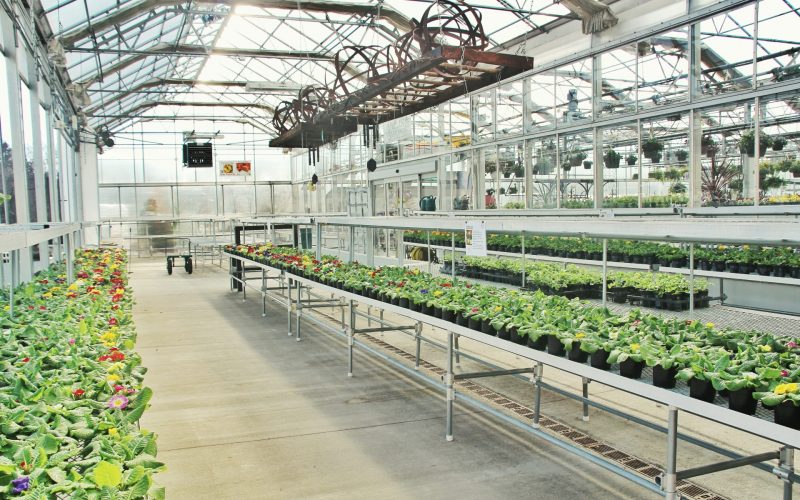With the greenhouse temperature difference, you can have your microclimate regardless of the weather outside. There’s so much more to greenhouses than extending the growing season and protecting plants from the elements. It’s the perfect space to grow out-of-season plants all year round – even in the coldest months of the year!
Do You Need to Heat a Greenhouse?
It depends on where you’re located. Plants mainly need four things to survive: water, sunlight, air, and nutrients. They undergo chemical reactions (respiration and photosynthesis) to grow healthy. To do that, your plants need energy in the form of heat/sunlight. If the temperature is too low, the growth of your plants slows down.

Gardeners in warmer climates with moderate temperature drops during winter can use an unheated greenhouse. Sunlight would be enough to raise the temperature, but make sure it doesn’t overheat on days with high humidity.
On the other hand, if the weather is below freezing, the thin layer of plastic or glass won’t be enough to keep your plants protected. You may need to insulate it to keep your plants happy. While some areas still get a lot of sun during winter days, an uninsulated greenhouse will cool off during the night. If this is the case, you may need to install a heating system.
How Cold Is Too Cold for a Greenhouse?
Since you can use a greenhouse to create your microclimate, you can use one as a hothouse or cold house. You can even have two climates in one greenhouse!
If you live in colder regions, like Montana, North Dakota, and Maine, you may prefer to keep your greenhouse warm and heated. The minimum nighttime temperature should be at least 55 degrees F.
For those living in warmer regions and prefer a cooler greenhouse, you can set the temperature to 45 degrees F. The maximum temperature for your greenhouse should be 90 degrees F during the daytime, all year round.
To maintain this temperature, regardless of the outside weather, there are ways to keep your greenhouse warm during winter. On the other hand, too much heat can damage your plants as well. If the sun is blazing, you can draw a shade at the top to block the heat.
What Are Cost-Effective Ways to Heat a Greenhouse?
There are different cost-effective ways to keep your greenhouse warm. Since greenhouses don’t stay warm in the winter, notably a full glass greenhouse, you want to protect your plants from harsh winter weather.
Here are some of the most cost-effective ways to do so:
Insulation
Insulating your greenhouse is vital in keeping your plants alive during winter. You can cover the windows and doors with bubble wrap to retain the heat. The bigger the bubbles, the more effective it is for insulation.
Install a cost-efficient heater
You don’t have to shell out thousands to install a heating system in your greenhouse. A heater running throughout winter will keep your plants warm throughout the season. You can use a digital thermometer to monitor and determine the greenhouse temperature difference.
Ventilation
To prevent your greenhouse from overheating, make sure that there’s enough ventilation throughout the area.
Shade
If the sun directly hits your greenhouse or if you live in an area with humid summers, shading your plants from the sun prevents them from getting burned. You can use roll-up screens made of aluminum or wood, paint-on materials, polypropylene shade cloth, and vinyl plastic shading.
Raise your plants off the ground
Most plants cannot survive in low soil temperatures. Raising them off the ground is the best solution to keep the coldness of the soil from transferring to your plants. You can recycle old pots or any other container.
Why Are Greenhouses Worth the Investment?
Greenhouses are one of the best investments every gardener should consider. Here are some of the many reasons why greenhouses are an excellent investment:
Ideal Growing Environment
Whether you want to grow fruits, vegetables, or ornamental plants, growing them in a greenhouse keeps them warm and humid all year long.
You can customize your greenhouse to ensure that your plants are in their ideal growing environment. With a greenhouse, you’ll have enough heat and water vapor to maintain a warm climate even if it’s snowing outside.
Protect your plants
Keeping them in a greenhouse protects your plants from harsh weather, an infestation of seasonal pests like spider mites, locust swarms, and more. Keep your plants safe and healthy throughout the year.
Grow plants all-season
Want to grow an exotic plant? Or perhaps you want to plant tropical fruits in your area? Many gardeners know that some plants thrive best in certain seasons. If you invest in a greenhouse, you don’t have to wait for months before you can plant tomatoes, strawberries, or exotic plants.
With a greenhouse, you can control the climate and the temperature. This means you can start planting seasonal plants anytime you want.
Maintaining a Greenhouse Temperature Difference Won’t Burn a Hole in Your Pocket
You don’t have to spend a fortune to maintain a greenhouse temperature difference. Whether you’re preparing your greenhouse for spring or winter gardening, be sure to keep these tips in mind.
